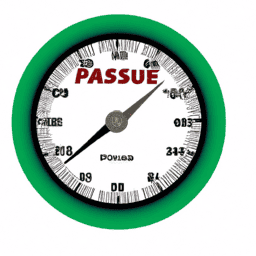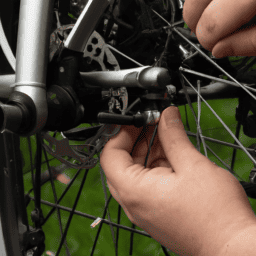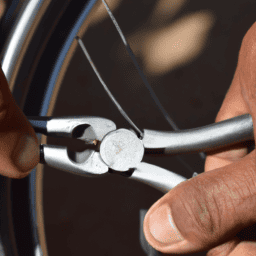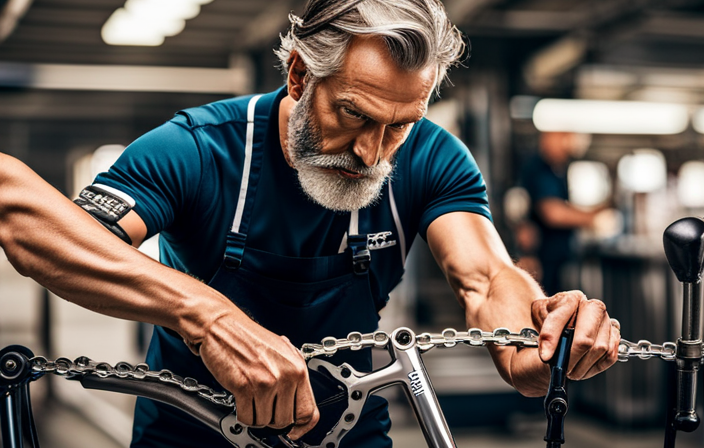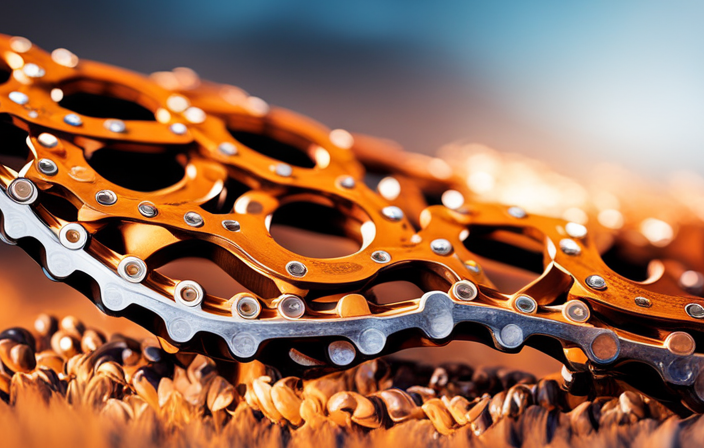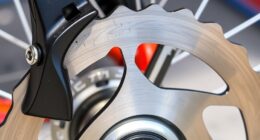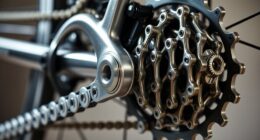While inflating the tires on my bicycle, it strikes me how crucial it is to keep the tire pressure at the appropriate level.
Just like a heart needs a certain amount of pressure to pump blood effectively, a bicycle tire requires a specific amount of air pressure to function optimally.
Determining the correct tire pressure for a bicycle can be a bit tricky, as it depends on several factors, including the type of tire, the weight of the rider, and the terrain being ridden on.
However, understanding these factors and regularly checking and adjusting tire pressure can greatly improve the performance and longevity of a bicycle tire.
In this article, I will delve into the specifics of how much air pressure should be in a bicycle tire, as well as the benefits of maintaining proper tire pressure.
Key Takeaways
- Proper tire pressure improves performance, safety, and fuel efficiency while reducing the risk of tire damage and premature tire failure and ensuring even wear and longer-lasting tires.
- Factors that impact tire pressure include the rider’s weight, terrain and riding style, type of tire, and temperature.
- Underinflated tires can be saggy and prone to pinch flats, while overinflated tires can result in reduced traction and a harsh ride.
- Checking tire pressure regularly using a gauge or by estimating pressure is essential, and appropriate tire pressure depends on the type of bike and riding, with heavier riders requiring higher pressure and smooth roads requiring less pressure than rough terrain.
Understanding the Importance of Tire Pressure
Want to avoid a bumpy and uncomfortable ride? Make sure you understand the importance of keeping the right amount of air pressure in your bicycle tire. The Importance of inflation can’t be overstated as it has a direct impact on your bicycle’s performance.
By keeping your tire properly inflated, you not only increase the lifespan of the tire but also enhance your ride quality.
When tires are underinflated, they become saggy and prone to pinch flats. Low pressure results in a larger contact patch between the tire and the ground, leading to increased resistance and making it harder to pedal.
Overinflated tires, on the other hand, can lead to reduced traction, making it harder to brake and corner. Therefore, it’s essential to maintain the optimal tire pressure, as recommended by the manufacturer.
Understanding the importance of tire pressure is the first step in ensuring a safe and enjoyable ride.
Maintaining proper tire pressure is crucial for a smooth and comfortable ride. But what factors should you consider when determining tire pressure?
Factors to Consider When Determining Tire Pressure
When determining the right tire pressure, it’s important to take into account factors such as the rider’s weight, terrain, and riding style. Heavier riders require higher tire pressure, while lighter riders need less air pressure. The terrain is also a crucial factor, as smooth roads require less pressure compared to rough terrain.
Additionally, the type of tire is also essential in determining tire pressure. For example, tubeless tires require less air pressure than tube-type tires. Another factor that impacts tire pressure is temperature. When the temperature drops, the air inside the tire contracts, leading to a decrease in tire pressure. Therefore, it’s essential to check tire pressure regularly, especially during the cold season.
On the other hand, hotter temperatures cause the air inside the tire to expand, leading to an increase in tire pressure. It’s crucial to check tire pressure regularly to ensure the right pressure is maintained, depending on the temperature and other factors mentioned above. When determining the right tire pressure, understanding the factors that impact tire pressure is essential.
However, knowing how to check tire pressure is equally important in ensuring the right pressure is maintained.
How to Check Tire Pressure
Checking tire pressure on a bike can be easily done using a tire pressure gauge, which measures the amount of force exerted on the tire. Here are some ways to check tire pressure:
-
Using a Gauge: The most accurate way to check tire pressure is by using a gauge. Simply remove the valve cap, press the gauge onto the valve stem, and read the measurement. It’s important to use the correct gauge for the type of valve on your bike (Schrader or Presta).
-
Estimating Pressure: If you don’t have a gauge, you can estimate tire pressure by squeezing the tire with your fingers. A properly inflated tire should feel firm and not give too much under pressure. However, this method is not as accurate as using a gauge.
-
Pros and Cons: Using a gauge provides the most accurate measurement of tire pressure, but it can be time-consuming and requires an additional tool. Estimating pressure is quicker and doesn’t require a gauge, but it’s not as precise.
-
Common Mistakes: Some common mistakes while checking tire pressure include not removing the valve cap, not pressing the gauge onto the valve stem firmly enough, and not holding the gauge straight. These mistakes can result in inaccurate readings.
To ensure optimal performance and safety, it’s important to check tire pressure regularly.
In the next section, we’ll discuss how to adjust tire pressure to the correct level.
How to Adjust Tire Pressure
So, now that I know how much air pressure should be in my bicycle tire, it’s time to learn how to adjust it.
The two main ways to adjust tire pressure are adding air or releasing air. To add air, I’ll need a pump and to release air, I can use a valve on the tire or a separate tool called a valve core remover.
Adding Air
To ensure optimal performance, it’s important to regularly add air to your bike tires. As the saying goes, "a stitch in time saves nine."
When adding air to your tires, it’s important to consider the type of pump you’re using. There are two main types of pumps: floor pumps and hand pumps. Floor pumps are larger, more stable, and easier to use for adding air quickly, while hand pumps are smaller, more portable, and better suited for emergency fixes.
Regardless of the pump type you choose, it’s important to use a pressure gauge to determine the correct amount of air pressure to add. The appropriate pressure for your bike tires will depend on the type of bike you have and the type of riding you’ll be doing. For example, a road bike may require a higher pressure than a mountain bike.
Once you’ve determined the correct pressure, simply attach the pump to the valve stem and add air until the gauge reads the appropriate number. As you begin to add air, it’s important to keep an eye on the gauge and not over-inflate the tire. Over-inflation can cause the tire to burst and can be dangerous.
If you accidentally add too much air, you can release air by pressing down on the valve stem with a fingernail or the tip of a pen. This will release a small amount of air at a time, allowing you to slowly bring the pressure down to the appropriate level.
Releasing Air
After learning about adding air to a bicycle tire, it is important to also understand the proper technique to release air. Releasing air from a tire can be done by pressing on the small valve stem with a tool or fingernail. It is important to release air slowly and gradually, as this can prevent damage to the tire or valve.
There are safety precautions to keep in mind when releasing air from a tire. One should wear protective gloves and eye goggles to avoid any injury from the sudden release of air. It is also important to stand to the side of the tire to avoid any potential injury from the tire or wheel. Additionally, it is important to be aware of the effects of over inflation and under inflation. Over inflation can cause the tire to burst, while under inflation can cause the tire to wear unevenly and lead to a decreased lifespan. By understanding the proper technique and safety precautions for releasing air from a bicycle tire, one can maintain the optimal air pressure and extend the lifespan of the tire.
Maintaining proper tire pressure has several benefits, including increased safety, better handling, and improved fuel efficiency. By keeping the tire pressure within the recommended range, the tire will wear evenly and provide better traction and control while riding. Additionally, maintaining proper tire pressure can improve fuel efficiency and save you money on gas. With the knowledge of how to properly release air from a tire, one can ensure that they are maintaining the proper air pressure and reaping the benefits of a well-maintained bicycle tire.
Benefits of Maintaining Proper Tire Pressure
You’ll notice a smoother ride and longer-lasting tires when you maintain proper air pressure. Proper tire pressure offers improved performance and increased safety.
Overinflated tires can cause a harsh ride and reduce traction, while underinflated tires can cause poor handling and increase the risk of a blowout. Maintaining the correct air pressure in your tires ensures that your bicycle handles well, providing a smooth ride and a secure grip on the road.
In addition to improved performance and increased safety, maintaining proper tire pressure also reduces the risk of tire damage. Overinflated tires can cause the tire to wear unevenly, which can lead to premature tire failure. Underinflated tires can cause the tire to flex more than it is designed to, which can cause the tire to overheat and possibly fail.
By checking and maintaining the proper air pressure, you can ensure that your tires wear evenly and last longer, saving you money in the long run.
Frequently Asked Questions
Can I use any type of air pump to inflate my bicycle tire?
I can use different types of air pumps for my bicycle tire, such as floor pump or hand pump. Each has its pros and cons. To properly attach the pump to the valve, I need to make sure it matches the valve type.
Is it possible to over-inflate my bicycle tire?
Did you know that over-inflated bicycle tires are at risk of bursting? To avoid this danger, it’s crucial to check and adjust tire pressure regularly. Use a pressure gauge and follow manufacturer guidelines for proper inflation levels.
How often should I check my bicycle tire pressure?
Checking my bicycle tire pressure regularly is crucial for consistent performance and safety. Optimal tire pressure for different terrains varies, so I ensure I check before each ride. Consistency is key.
Will riding with low tire pressure affect my speed?
Oh boy, let me tell you, riding with low tire pressure is like trying to run through quicksand. It will definitely slow you down and impact your handling. Plus, it can wear out your tires faster. So, keep those tires properly inflated!
Is it okay to use the maximum tire pressure listed on the tire sidewall?
Using the maximum tire pressure listed on the sidewall can lead to a harsh ride and decreased traction. Lower tire pressure can provide better comfort and traction, but it can also decrease the lifespan of your tire. Consider your riding style and conditions for optimal pressure.
Conclusion
In conclusion, understanding the importance of tire pressure is crucial for every cyclist. It affects the performance, comfort, and safety of the ride.
Factors that affect the determination of tire pressure include the rider’s weight, road conditions, and tire size. Checking tire pressure regularly helps to maintain optimal performance and prevent tire damage.
Adjusting tire pressure is a simple task that requires a tire gauge and a pump. Keeping the tire pressure at the recommended level reduces rolling resistance, increases grip, and ensures a smooth ride.
So, don’t forget to inspect your tires before every ride and adjust the pressure accordingly. Remember, the question isn’t how much air pressure should be in a bicycle tire, but rather, how much air pressure in your bicycle tire can enhance your riding experience?
